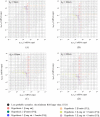Role of fomites in SARS transmission during the largest hospital outbreak in Hong Kong
- PMID: 28727803
- PMCID: PMC5519164
- DOI: 10.1371/journal.pone.0181558
Role of fomites in SARS transmission during the largest hospital outbreak in Hong Kong
Abstract
The epidemic of severe acute respiratory syndrome (SARS) had a significant effect on global society in the early 2000s and the potential of its resurgence exists. Studies on the modes of transmission of SARS are limited though a number of outbreak studies have revealed the possible airborne route. To develop more specific and effective control strategies, we conducted a detailed mechanism-based investigation that explored the role of fomite transmission in the well-known Ward 8A outbreak. We considered three hypothetical transmission routes, i.e., the long-range airborne, fomite and combined routes, in 1,744 scenarios with combinations of some important parameters. A multi-agent model was used to predict the infection risk distributions of the three hypothetical routes. Model selection was carried out for different scenarios to compare the distributions of infection risk with that of the reported attack rates and select the hypotheses with the best fitness. Our results reveal that under the assumed conditions, the SARS coronavirus was most possible to have spread via the combined long-range airborne and fomite routes, and that the fomite route played a non-negligible role in the transmission.
Conflict of interest statement
Figures




References
-
- Ksiazek TG, Erdman D, Goldsmith CS, Zaki SR, Peret T, Emery S, et al. A novel coronavirus associated with severe acute respiratory syndrome. N Engl J Med. 2003;348: 1953–1966. doi: 10.1056/NEJMoa030781 - DOI - PubMed
-
- World Health Organization. Summary of probable SARS cases with onset of illness from 1 November 2002 to 31 July 2003. 21 Apr 2004. Available from: http://www.who.int/csr/sars/country/table2004_04_21/en. Cited 20 Dec 2016.
-
- World Health Organization. Situation updates–SARS. 2016. Available from: http://www.who.int/csr/don/archive/disease/severe_acute_respiratory_synd.... Cited 20 Dec 2016.
-
- World Health Organization. Severe acute respiratory syndrome (SARS) in Singapore: Update 2. 24 Sep 2003. Available from: http://www.who.int/csr/don/2003_09_24/en. Cited 20 Dec 2016.
-
- World Health Organization. Severe acute respiratory syndrome (SARS) in Taiwan, China. 17 Dec 2003. Available from: http://www.who.int/csr/don/2003_12_17/en. Cited 20 Dec 2016.
MeSH terms
LinkOut - more resources
Full Text Sources
Other Literature Sources
Miscellaneous

